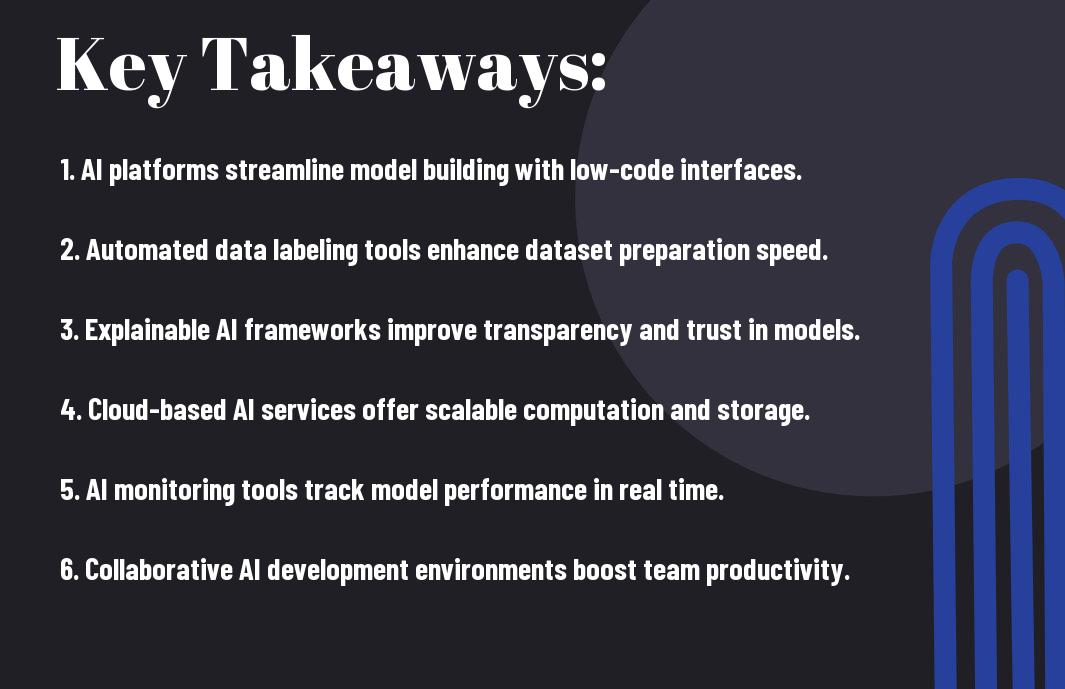With the rapid evolution of technology, understanding the latest AI development tools is crucial for your business to stay competitive. In this post, you’ll discover a range of innovative tools designed to streamline processes, enhance productivity, and drive transformative results across various sectors. You will learn how to leverage these cutting-edge solutions to improve decision-making, automate tasks, and ultimately position your company for success in an increasingly AI-driven landscape.
The Rise of No-Code Platforms Transforming AI Accessibility
No-code platforms are driving a significant shift in how businesses approach AI development. By eliminating the need for extensive coding knowledge, these tools empower entrepreneurs and teams to build, deploy, and manage AI solutions with greater ease and speed. This democratization of technology allows people from various backgrounds to contribute innovative ideas without the barrier of complex programming skills.
How No-Code Revolutionizes Development
The no-code movement revolutionizes development by streamlining workflows and enhancing collaboration across teams. With user-friendly interfaces, businesses can rapidly prototype AI applications, facilitate iterative testing, and implement changes based on user feedback—all without extensive technical training. As a result, you can focus on driving value through your ideas rather than getting tangled in coding intricacies.
Popular No-Code AI Tools to Consider
Several no-code AI tools are reshaping the landscape, enabling businesses to harness the power of artificial intelligence. Platforms like Bubble, which allows users to create web applications without coding, and DataRobot, providing a streamlined way to build machine learning models, are gaining traction. Additionally, Zapier connects various applications, automating tasks and integrating AI capabilities seamlessly, while Lobe helps you train machine learning models visually. Each of these tools facilitates not only faster deployment but also fosters creativity in AI-driven projects.

Advanced Machine Learning Frameworks Reshaping Data Analysis
The landscape of data analysis is rapidly evolving, thanks to advanced machine learning frameworks such as TensorFlow and PyTorch. These powerful tools enable your business to harness vast amounts of data, extracting insights that drive decision-making and operational efficiency. By leveraging their capabilities, you can create sophisticated models that predict trends, optimize processes, and enhance customer experiences. For a deeper investigate the Best AI Tools Every Business Should Use in 2025, consider incorporating these frameworks into your data strategy.
Framework Comparison
| TensorFlow | Built by Google, it excels in large-scale ML tasks and production deployment. |
| PyTorch | Developed by Facebook, it’s favored for research due to its dynamic computation graph. |
Unpacking TensorFlow and PyTorch
TensorFlow stands out for its robust ecosystem, extensive libraries, and scalability across different devices, making it an ideal choice for large enterprises handling massive datasets. In contrast, PyTorch embraces simplicity and flexibility, allowing for rapid prototyping, which is especially beneficial in academic and research settings. Both frameworks are open-source, fostering community contributions that enhance their capabilities.
Use Cases That Highlight Their Power
TensorFlow and PyTorch have revolutionized how industries operate by enabling applications such as natural language processing (NLP), computer vision, and predictive analytics. In healthcare, these frameworks facilitate real-time diagnostics by analyzing medical images; in finance, they support algorithmic trading by predicting stock movements based on data trends. Such applications showcase their potential to transform decision-making processes across various sectors.
Real-world examples of TensorFlow and PyTorch’s power include Google’s use of TensorFlow for voice recognition in Google Assistant and Facebook’s research with PyTorch to develop sophisticated AI models for content personalization. With the ability to analyze millions of data points quickly, these frameworks empower businesses to make more informed decisions, adapt to market changes, and ultimately, enhance competitive advantage.
The Role of AI in Enhancing Collaboration and Productivity
AI has a profound impact on team dynamics, streamlining workflows, and fostering enhanced collaboration. By automating mundane tasks and providing intelligent insights, AI allows your team to focus on high-value activities, resulting in increased productivity. Tools powered by AI not only help you manage projects more efficiently but also facilitate seamless communication across departments, ensuring everyone stays aligned with objectives and deadlines.
AI-Powered Project Management Tools
AI-powered project management tools bring unprecedented efficiency to your team’s workflow. These platforms analyze historical data and provide predictive insights to help you allocate resources effectively, forecast project timelines, and identify potential bottlenecks. By automating scheduling and task assignments, these tools free up valuable time, allowing you to concentrate on strategic planning rather than getting bogged down in administrative tasks. Solutions like Asana and Trello are already integrating AI features to enhance your project management experience.
Communication Enhancements through Natural Language Processing
Natural Language Processing (NLP) tools significantly enhance communication within your organization. By enabling chatbots and virtual assistants, these tools can interpret and respond to queries in real-time, ensuring prompt support. Text summarization features can condense lengthy emails and documents, allowing you to quickly grasp crucial information without sifting through unnecessary details. Solutions like Grammarly or Drift not only improve clarity in communications but also help in maintaining a professional tone across various platforms.
Jargon and miscommunication can lead to misunderstandings that slow progress. NLP tools mitigate these barriers by offering real-time suggestions, translation services, and even sentiment analysis, making your interactions more effective. For example, tools like Google’s Dialogflow empower your team with advanced conversational AI capabilities, enabling seamless interaction with clients or among team members. By fostering a clearer exchange of ideas, NLP enhances collaboration and ensures that your team can work cohesively toward shared goals.
Ethical AI Development: Navigating Challenges and Responsibilities
Deepening your understanding of ethical AI development is important as businesses leverage these powerful technologies. Addressing challenges like bias, transparency, and accountability will not only enhance your AI systems but also build trust with stakeholders. Leveraging insights from resources like 7 Emerging AI Tools Every Tech Leader Should Know in 2025 can give you a competitive edge while ensuring responsible AI practices.
Addressing Bias in AI Tools
Bias in AI tools can lead to significant consequences, impacting decision-making processes and perpetuating inequality. It’s important for you to conduct rigorous testing and validation of your AI algorithms to ensure they are free from biases related to race, gender, and socioeconomic status. Incorporating diverse datasets and leveraging techniques like bias mitigation can help you achieve more equitable outcomes in your AI initiatives.
Building Trust through Transparency and Accountability
Your stakeholders will expect transparency and accountability in your AI systems. Establishing clear communication around how these technologies work, including the data used and decision-making processes, fosters trust in your organization’s AI implementations. By actively engaging with users and providing them insight into the algorithms, you can mitigate fears and enhance acceptance of AI-driven solutions.
Transparent practices include regular reporting on AI performance metrics and potential biases, which are critical for your organization to maintain credibility. Engaging diverse stakeholders in AI discussions can help you gather valuable feedback, ensuring your systems meet varied expectations. Ultimately, demonstrating accountability through clear policies and governance frameworks reinforces trust in AI solutions, paving the way for wider adoption and positive societal impact.

The Future Landscape of AI Tools: Trends to Watch
Anticipating the future of AI tools reveals a landscape rich with innovations poised to reshape industries and workflows. As machine learning models evolve, expect more sophisticated applications, such as automated content creation and real-time decision-making. Furthermore, integrations with emerging technologies like blockchain and quantum computing can amplify capabilities, enhancing everything from data security to processing power. Being vigilant about these trends will empower you to leverage opportunities that can widen your competitive edge.
Emerging Technologies on the Horizon
Technologies such as edge computing and natural language processing (NLP) are set to revolutionize how AI operates on various levels. Edge computing minimizes latency by processing data near its source, leading to faster insights and more efficient operations. NLP advancements will make interactions with AI interfaces more intuitive, allowing for richer customer experiences and more streamlined business communications.
Implications for Businesses Adopting Early
Businesses that adopt these emerging AI technologies early stand to gain significant advantages, including increased efficiency and enhanced customer satisfaction. Pioneers in AI integration are often positioned to capitalize on new revenue streams, innovate faster than competitors, and respond swiftly to market changes. Consider how organizations like Amazon and Google implemented machine learning long before their competitors, significantly boosting their market dominance.
By embracing AI tools early on, you maximize your ability to innovate and adapt within your sector. For example, companies utilizing advanced machine learning models for analytics have reported a reduction in operational costs by as much as 30%. You will also likely cultivate a cutting-edge reputation within your industry, attracting top talent and new clients eager to work with a forward-thinking organization. The early adoption of AI not only strengthens your position in a competitive marketplace but also invites collaboration with tech leaders, opening doors to further advancements and integrations.
Final Words
Conclusively, staying informed about emerging AI development tools is imperative for enhancing your business operations and driving innovation. By leveraging tools like AI-driven analytics, chatbots, and automation platforms, you can streamline processes, improve customer engagement, and make informed decisions. By integrating these technologies into your workflow, you empower your team to focus on strategic initiatives while enhancing productivity. Ensuring your business adapts to these advancements will position you competitively in an evolving marketplace.







